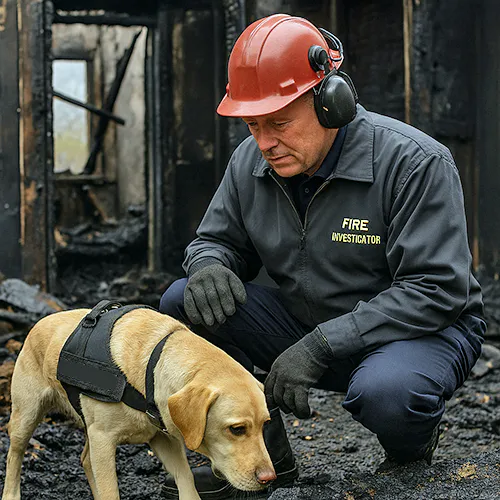
In the aftermath of a fire, the scene can be chaotic and difficult to read. Charred remains, collapsed structures and the smell of smoke can mask the clues that point to how the blaze began.
For investigators, one of the most important questions is whether the fire was accidental or deliberate. When arson is suspected, the search for accelerants becomes a priority. Accelerants are substances such as petrol or paraffin that can be used to start or spread a fire. Detecting them quickly and accurately can make the difference between solving a case and leaving it unresolved.
This is where accelerant detection dogs play a vital role. These dogs are trained to identify the scent of a wide range of ignitable liquids, even when present in minute quantities – as low as one part per trillion!, which makes them far more sensitive than any mechanical device currently available. While laboratory analysis is still essential for confirmation, a dog can guide investigators to the most promising areas to sample, saving time and resources.
The training of an accelerant detection dog is a careful process. It begins with selecting a dog that has the right temperament and drive to work. Many are Labradors or similar breeds known for their focus, eagerness to please and ability to work in varied environments. The dog is gradually introduced to the scents of different accelerants and rewarded for indicating their presence. Over time, the dog learns to ignore other strong odours such as burnt wood, plastics or household chemicals, and to respond only to the target scents.
In the field, the dog works on a lead with its handler, moving methodically through the scene. When it detects an accelerant, it gives a trained indication, often by sitting or lying down at the spot. The handler marks the location so that a sample can be collected for laboratory testing. This partnership between dog and handler is built on trust and clear communication. The handler must be able to read the dog’s body language and understand when it is making a genuine find.
One of the challenges in fire investigation is that accelerants can evaporate or be consumed by the fire. However, residues often remain in porous materials such as wood, carpet or soil. Dogs can detect these residues even when they are not obvious to human senses. Their ability to work quickly across large or complex scenes means that potential evidence is less likely to be missed.
Accelerant detection dogs are not only used at the scene of a fire. They can also be deployed to search vehicles, clothing or other items linked to a suspect. In some cases, their work has led directly to arrests and convictions. Their presence can also act as a deterrent, making it clear that attempts to conceal the use of accelerants are unlikely to succeed.
Handlers of accelerant detection dogs are often experienced fire investigators or police officers. They receive specialist training alongside their dogs, learning how to work safely in fire-damaged environments and how to preserve the integrity of evidence. The bond between handler and dog is strengthened by daily training and regular operational work, which ensures that the dog’s skills remain sharp and the team can perform reliably under pressure.
Public awareness of accelerant detection dogs is growing, but their work is often behind the scenes. They may not be visible in courtrooms or on the news, yet their findings can be central to a case. In some jurisdictions, the dog’s alert is considered probable cause for further investigation, though it is always backed up by laboratory confirmation.
The use of dogs in arson investigation is part of a wider tradition of working dogs assisting humans in specialised tasks. Just as dogs have been used to detect drugs, explosives or even medical conditions, their role in fire investigation shows how adaptable and valuable they can be. Each discipline requires its own training and handling techniques, but all rely on the same fundamental qualities of the dog’s nose and its willingness to work with people.
In the UK and elsewhere, accelerant detection dogs are often funded and managed by fire and rescue services or police forces. Some are provided through partnerships with insurance companies, recognising the value of reducing arson-related losses. The investment in training and maintaining these dogs is significant, but the return in terms of solved cases and prevented crimes is considerable.
Looking ahead, technology may continue to improve, but it is unlikely to replace the role of the dog entirely. The combination of mobility, sensitivity and decision-making that a trained dog offers is difficult to replicate. As long as arson remains a threat, there will be a place for these canine investigators in the toolkit of fire scene examination.
The work of accelerant detection dogs is a reminder that even in a world of advanced forensic science, some of the most effective tools are living, breathing partners. Their contribution to public safety is enormous, not only in the cases they help solve but in the deterrence they provide. By making it harder for arsonists to hide their actions, they help protect communities from the damage and danger of deliberate fire setting.
